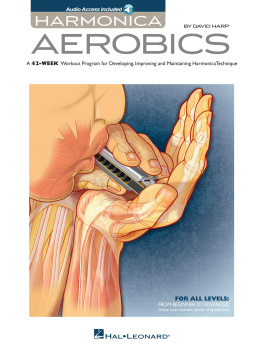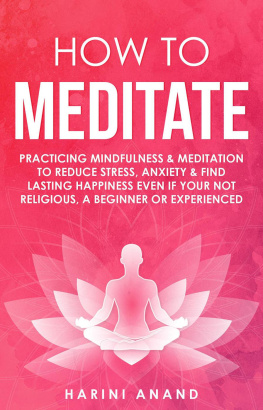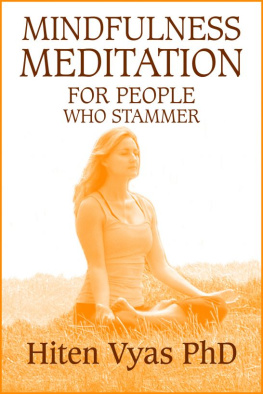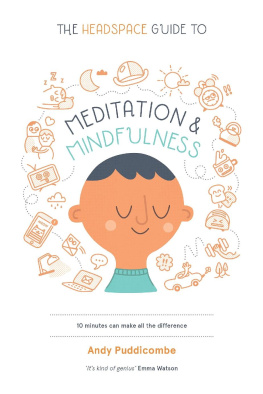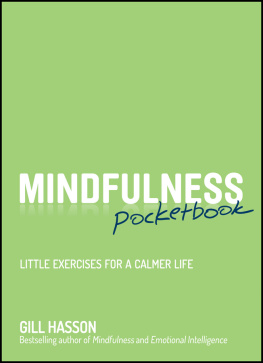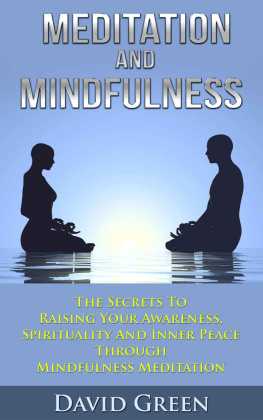My appreciation as always to my old friend and mentor Matthew McKay, Ph.D., for his help with this book as well as so many other things.
Id also like to thank Joshua Boger and Justin Morreale. Joshua not just for his kindness to me and mine, but for the inspiration he provides by demonstrating that someone can be incredibly active and very kind and mindful as well. And Justin not just for his early and ongoing support of my work, but for the clarity of his own mindfulness that informs and infuses mindfulness in those with whom he comes in contact.
I must also acknowledge and thank three groups: the many tens of thousands of attendees at my corporate events, all of the students who have attended my longer workshops at the New York Open Center and the Kripalu Center, and my beloved children and wife, from whom Ive learned so much.
bibliography
References
American Psychological Association Mind/Body Health Public Education Campaign. 2007. Stress in America Survey. Washington, D.C.: American Psychological Association.
Csikszentmihalyi, Mihaly. 1990. Flow: The Psychology of Optimal Experience. New York: Harper Perennial.
Garfield, Charles A. 1978. Psychosocial Care of the Dying Patient. New York: McGraw-Hill.
Resources
Harp, David, and Matthew McKay. 2005. Neural Path Therapy: How to Change Your Brains Response to Anger, Fear, Pain, and Desire. Oakland: New Harbinger Publications.
Harp, David, and Nina Smiley. 2008. The Three Minute Meditator, fifth edition. Montpelier, VT: minds i press.
Kornfield, Jack. 1993. A Path with Heart. New York: Random House.
Levine, Stephen. 1997. A Year to Live:How to Live This Year As If It Were Your Last. New York: Bell Tower.
Levine, Stephen, and Ondrea Levine. 1982. Who Dies? An Investigation of Conscious Living and Conscious Dying. New York: Anchor Press.
Nisargadatta, Sri, and Maurice Frydman. 1973. I Am That. Durham, NC: Acorn Press.
Smiley, Nina, and David Harp. 1989. MetaPhysical Fitness: The Complete Thirty-Day Program for Your Mental, Emotional, and Spiritual Health. Montpelier, VT: minds i press.
David Harp, MA, is a corporate speaker, cognitive behavioral therapy trainer, and author of numerous books, including The Three Minute Meditator, Neural Path Therapy, and MetaPhysical Fitness. He specializes in training groups of all sizes and types to consciously control what is commonly known as the fight-or-flight response, which produces fear and anger. Harp is also Americas best-known harmonica teacher, with over a million students to his credit. He lives in Middlesex, VT.

mindfulness what, why, and how
Life is motion. From the orbits of the subatomic particles that provide the stuff of the universe to the migrations of species, movement is an intrinsic part of life. Yet many of us think that mindfulnessthe transformative state of being that Ill describe in a momentcan be practiced only during a state of stillness, of sitting quietly in a bedroom or monastery. Thats not just wrong, its counterproductivebecause we can both learn to be mindful, then become mindfulon the go. In fact, for many of us, learning to be mindful is actually easier when we do it while going about the movements of our regular daily life.
What Is Mindfulness?
There are many ways to define mindfulness. My own convenient, simple, andmost importantlyuseful definition might be stated like this: the state of mind in which we can choose either to be fully aware on many different levelswhether physical, mental, or philosophicalat once, or to focus our awareness on any of these various levels at will.
Perhaps you feel as though you can already do this (stay aware of different levels of perception, or focus upon any of them at will). And perhaps you can. Walking down a quiet country road at night, you may find it easy to look up at the stars and marvel at the universe, then listen to the sound of your own footsteps in the road. Of course, driving down a congested street during rush hour with a car full of squabbling passengers and a gas gauge below empty may be a different story.
So, lets be honest with ourselves. Most of us, myself included (its easier to preach than to practice), allow our minds and thoughts to have a great deal of control over our emotions, our words, and our actions.
Cultivating a state of mindfulness helps us to notice these un-useful thoughts, remember how to short-circuit the negative consequences they will produce if allowed to continue, and turn the focus of our attention back to the necessities of the situation. The exercises in this book will help you foster this state.
How Mindfulness Differs from Meditation
Mindfulness is the state we wish to achieve. Meditations are the exercises we do to get there. The relationship between the state of mindfulness and the meditation exercises that youll begin practicing shortly is like the relationship between the state of being a great baseball player and the exercises of running, weight-training, batting practice, and catching practice.
What Is Mental Muscle?
Mental muscle is my own term for the ability to use the senses to direct the brains attention to any particular object. Some objects, such as a James Bond movie, grab and hold our full attention with exciting chase scenes, beautiful faces and bodies, and villains with great lines. But staying focused on something that is not intrinsically interesting has certain costs to us. Thats why our schoolteachers rarely asked us to give or turn our attention to lists of state capitals or times tablesthey told us to pay attention to them.
Focusing on things that are easy to focus on, whether Hollywood movies or our own fears or angers, does not require mental muscle: the opposite is true. When we lack mental muscle, our attention naturally gravitates to those thoughts or things that are the most compelling or engrossing for us, even when this is not desirable. If you find yourself thinking about lunch when youre supposed to be working, or about work when youre supposed to be lunching, you could probably stand to build up your mental muscle.
Its simple to understand how to build physical muscle (barbell curls for biceps, crunches for abdominal muscles), but its not easy to find the time or the will to practice the exercise over and over until you get the desired results. Just as physical muscle results from doing physical exercise, mental muscle results from doing meditative exercises. Simple, right? But again, not easy for many of usespecially for those of us who have never found a style or program of meditation that we can easily understand, and then stick to.
Birds, Bats, Barnacles, and Bees
In my earlier work, I developed the concept of birds, bats, barnacles, and bees in relation to meditation practice. These animal termssimplistic though they may beare an easy way to acknowledge the fact that most people have preferred modes of perceiving, processing, and using information. Birds have great eyesight: an eagle can spot a mouse from a mile up. People who are like birds in my terminology will tend to prefer visually-based meditation exercises, and they may prefer to learn meditation by a visual method: a person or DVD rather than a book or CD.
Bats, as you may have guessed, are audio-preferring folk. Theyll probably enjoy mantra (sound-based) meditations, and will want to learn by listening, not looking or feeling. Barnacles dont get around much, nor do they want to. They live in one place, and their tiny, feathery fingers constantly taste and test the water. Barnacle people like taste-and-smell meditations, or meditations that involve noticing physical sensation while one is not moving, such as focusing attention on the feeling of ones rear as it sits in a chair.


